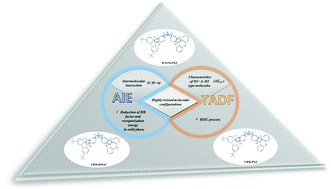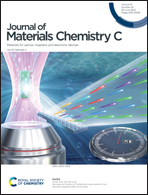Theoretical studies on the excited-state properties of thermally activated delayed fluorescence molecules with aggregation induced emission†
Abstract
Recently, thermally activated delayed fluorescence (TADF) molecules with aggregation induced emission (AIE) features have attracted much attention. However, the relationships between basic molecular structures and photophysical properties are unclear and the corresponding theoretical investigations to reveal the inner AIE and TADF mechanisms are highly desired. Herein, the excited state properties of three TADF molecules (CBM-DMAC, 3CPyM-PXZ and CBM-PXZ) are theoretically studied both in solution (tetrahydrofuran (THF)) and solid phase, respectively. The solvent environment in THF is considered by using a polarizable continuum model (PCM) and the molecules in the solid phase are investigated by a combined quantum mechanics and molecular mechanics (QM/MM) method. The luminescence properties are investigated using density functional theory (DFT) and time-dependent density functional theory (TD-DFT) calculations coupled with the thermal vibration correction function (TVCF) method. The results show that asymmetrical molecules with donor(1)–acceptor–donor(2) (D1–A–D2) constructions are beneficial for obtaining a small energy gap with well separated orbital distributions, and enhanced spin–orbit coupling (SOC) effects are determined in the solid phase, which confirm the TADF features. Furthermore, all studied molecules possess twisted molecular configurations, and remarkable intermolecular C–H⋯π and C–H⋯O interactions can be observed in the solid phase, which promotes the aggregation induced emission (AIE) and TADF properties. Moreover, geometrical changes between the ground state (S0) and lowest singlet excited state (S1) can be effectively hindered in the solid phase, which leads to the reduction of Huang–Rhys (HR) factor and reorganization energy compared with those in THF. Thus, the non-radiative energy decay process is hindered and the AIE mechanism is revealed. Our investigations are devoted to revealing the relationship between the molecular structures and photophysical properties, AIE and TADF mechanisms are theoretically illustrated, which could facilitate the development of new efficient TADF emitters.



 Please wait while we load your content...
Please wait while we load your content...